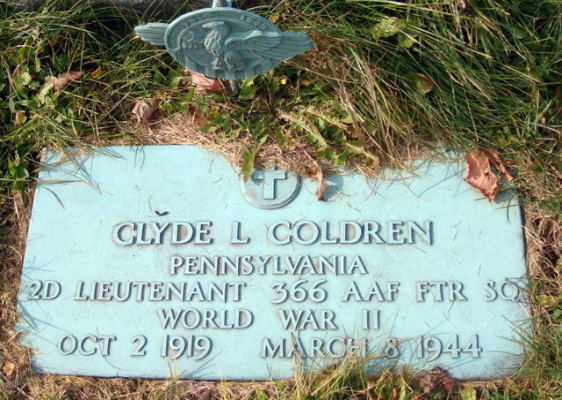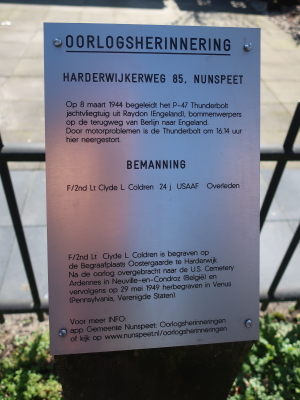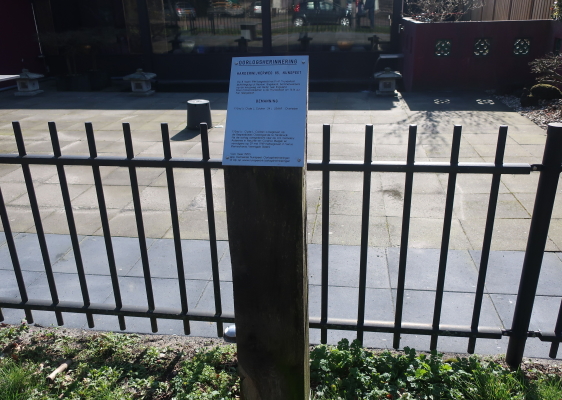A Thunderbolt crashes
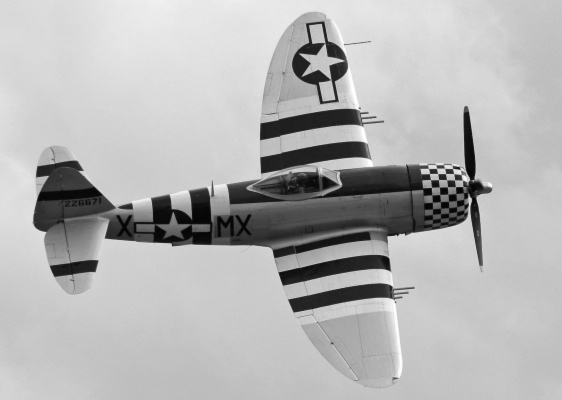 It was Wednesday, March 8, 1944. It was prayer day. At Harderwijkerweg 85 there was a shop where yarn, ribbon, beer, lemonade, chocolate, laces and much more was sold. The shop was owned by Karel Kremer and his sister Dia. Karel is 73 years old and Dia is 71. Dia ran the shop and brother Karel went with a wheelbarrow full of stuff to the houses in Hierden, Hulshorst and Doornspijk to sell. Behind the shop was a small farm. Jacob Fidder lived there.
It was Wednesday, March 8, 1944. It was prayer day. At Harderwijkerweg 85 there was a shop where yarn, ribbon, beer, lemonade, chocolate, laces and much more was sold. The shop was owned by Karel Kremer and his sister Dia. Karel is 73 years old and Dia is 71. Dia ran the shop and brother Karel went with a wheelbarrow full of stuff to the houses in Hierden, Hulshorst and Doornspijk to sell. Behind the shop was a small farm. Jacob Fidder lived there.
The eighteen-year-old daughter Aaltje was home alone and was peeling potatoes. She was very frightened. A plane came down burning. It crashed right behind the house. The pilot who was still trying to jump out of the plane fell to his death on the path to the farm. The thatched roof of the shop caught fire because of the inferno. The house burned to the ground. A small stock of goods could still be taken from the shop. Many people were looking at the burning shop and the crashed plane. It was an American fighter of the Thunderbolt type. Such a plane had only one occupant. The police cordoned off the area. A group of German soldiers came and chased the people off the road. Two of those German soldiers looted the pilot. Josef Frontzek took a wallet with Dutch, French and Belgian money, a wristwatch, a pocket watch, a bundle of maps and a box with gauze, a compass, chocolate and about twenty photos.
When Oberfeldwebel Gerhard came, Frontzek had to give up part of the loot. It is certain that Frontzek kept the wristwatch. The photos were torn up. Freight driver Anthonie Ton found one of the torn photos. He glued the pieces together and had the photo reprinted.
Clyde Lee Coldren
Pilot Clyde Lee Coldren was 24 years old and had a one and a half month old daughter.
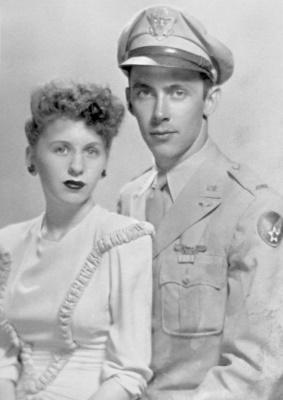 He was born on October 2, 1919 in Grandberry (Pennsylvania). He attended Brandeis High School and joined the United States Air Force in 1941. In 1943 he became a 2nd lieutenant. Coldren married Joan Bessie Price on February 6, 1943. Daughter Candace Lee Coldren was born on January 22, 1944.
He was born on October 2, 1919 in Grandberry (Pennsylvania). He attended Brandeis High School and joined the United States Air Force in 1941. In 1943 he became a 2nd lieutenant. Coldren married Joan Bessie Price on February 6, 1943. Daughter Candace Lee Coldren was born on January 22, 1944.
Coldren flew a Republic P-47D Thunderbolt, a single-engine fighter plane, belonging to the 358th Fighter Group, 366 Squadron. The base was Raydon in Suffolk (England). The squadron to which he belonged had escorted bombers to Berlin on March 8, 1944. Second Lieutenant Harold L. McClellan gave an account of what had happened in a report about the crashed plane. Coldren had problems with his propeller. McClellan flew next to him to make contact. Coldren did not respond via radio. The plane lost altitude. McClellan reported: ‘At 10,000 feet the propeller stopped turning. I then called my commander and told him we were 10,000 feet east of the Zuiderzee and explained the situation. Coldren said nothing over the radio. We continued to lose altitude, but Lieutenant Coldren did not jump. I continued circling at 4,000 feet and saw Lieutenant Coldren’s glide stop abruptly at 3,000 feet. The plane began to spin and hit the ground just west of Zwolle. There was a large explosion. At that moment the anti-aircraft defenses became active. I took a safe route back.’
Coldren was buried at the Harderwijk General Cemetery on March 11, 1944, and after the war was transferred to the U.S. Military Cemetery in Neuville-en-Condroz, Belgium. He was reinterred in Venus, Pennsylvania, on May 29, 1949. After the war, Karel and Dia Kremer’s shop was rebuilt. It was given the name Kremershofje. Later it became restaurant De Schouw and then restaurant Ni-Hao. The shape of the original shop can still be seen. Source: o.a. Elspeet Historie


